This is a continuation from Part 1
Map of the route for the journeys covered in this part-
These are the trains we take during this trip-
- 19221 Somnath Express from Ahmedabad to Veraval (pink)
- 52929 MG Passenger from Veraval to Dhasa Jn (red)
- 59226 Mahuva-Bhavnagar Passenger from Dhasa Jn to Dhola Jn (yellow)
- 09232 Bhavnagar-Bandra Special from Dhola Jn to Joravarnagar (blue)
- 19222 Somnath Express from Surendranagar to Ahmedabad (green)
– – – – –
Somnath Express ready for departure from Ahmedabad
Ahmedabad’s Kalupur railway station is a beehive of activity at night with trains arriving from and departing to all corners of the country every few minutes. My train, the Ahmedabad-Veraval Somnath Express is boarding from platform 10. By some stroke of luck, Abhishek who booked the tickets has managed to get three window seats for all three of us- we have lower berth, lower berth and side lower berth! I volunteer to take up the side berth which has relative lesser legroom, but is compensated by having two windows to myself, a decision I soon regret as the windows refuse to close shut tight, leaving a thin slit letting in chilled wind as the train gallops at over 100 km/hr through the cold winter night. I bundle up myself in a bedsheet, get some half-decent sleep and the next thing I know is we are pulling into Veraval bang on time, well before sunrise.
The Retiring Room at Veraval station is clean and functional
We have precisely three and half hours before our next train departs, so we head straight to the ticket counter and enquire if there is a retiring room available. It turns out there is one available, but it has no hot water because “the solar has stopped working”. Fine, we will take it. The retiring rooms sit just outside the station building and are quite decent for the price. I have no intention of taking a cold water bath after suffering the wrath of cold wind all night long, so I just dump my bags in the room, and off we go to squeeze in a quick trip to the famous Somnath temple (after which our train was named). A high-speed rickshaw ride through empty streets deposits us at the temple basking in the golden rays of the morning sun. The temple complex sits at the edge of the sea, with spectacular views, but alas, paranoid security concerns mean we are not allowed to carry camera or cell phones to photograph this beautiful place. Just outside the temple is a not-so-clean food stall preparing fresh hot Gujarati delicacies- jalebi, fafda, dhokla and masala chai. For a moment I worry about the hygiene of the place, but the sights and smells are too tempting and I give in. A hearty breakfast, and another breakneck speed rickshaw ride later, we are back to Veraval Junction to start our journey through the hinterlands.
Somnath temple shines in the morning sunlight
Veraval station overview. Meter gauge lines are in the right side corner
Our plan is to take the 9.40am Meter Gauge passenger from Veraval to Dhasa Junction reaching at 4.40pm, and connecting there to Broad Gauge passenger departing at 4.46pm to Dhola Junction. This six minute layover to change trains, including buying tickets was worrying me, but thankfully at Veraval they issue direct MG-BG combined tickets to Dhola Junction! That’s one less thing to worry now. Like everywhere else today, the meter gauge operations at Veraval are relegated to one corner, with most of the prime property taken over by the big brother mainline operations. Our seven coach train is already fairly full but a little walking around fetches us an empty bay with two windows, again with one Emergency Window with no bars. We depart right on time at 9.40am, and the landscape outside Veraval leaves me surprised. There are coconut palms, and abundant paddy farming. This is something I associate with coastal Kerala, not Saurashtra which, in my ignorant mind, was all dry and arid. The train stops at all stations, once every few minutes but the stops are extremely brief, most of them taking less than a minute. In about half an hour, we reach the first major stop- Talala Junction.
Delvada-Veraval Passenger is already waiting as we enter Talala Junction
My train- the seven coach Veraval-Dhasa Passenger stopped at the other end at Talala Jn
Talala Junction is a tiny station, with just one low platform and three additional tracks. The platform line is already occupied by the Delvada-Veraval Passenger that arrived before us, and transfer passengers are waiting on the tracks to board our train. The crowd settles in few minutes and I expect we will get going soon, but I am told that is not the case. A third train, from Junagadh and heading to Delvada (see map above to get an idea of the routes) is yet to arrive, and only after all three trains have arrived and passengers given a chance to transfer from either to all, will each of them depart. Oh the logistics! Since all these meter gauge lines in these rural areas see only one or two trains a day, the timetables are well synchronized so that passengers get an option to travel from anywhere to anywhere in the network. Since we have about half hour of wait remaining, I make friends with the local villagers sitting beside us, ask them to take care of our seats and bags, and get out to wander. Our train’s driver is also wandering outside. A brief chat with him reveals that the journey ahead through Gir National Park will be done at a restricted speed of 30 km/hr to avoid chances of wild animals being run over by the train.
Junagadh-Delvada Passenger gets the signal to enter Talala Jn, completing the trio
About forty minutes of wait later, a gateman goes to the outskirts of the station, manually lowers the semaphore signal, clearing the route for Junagadh-Delvada passenger to enter. As soon as that train arrives, and transferring passengers given sufficient time to jump across to our train, we get the first clearance out of the three trains to leave. Back in the coach, the locals have realized we “tourists” are the odd-men-out on this train, so they decide to be our local guides, telling us everything from history and geography of the region to what wildlife can be seen where. This is the best part of traveling in rural India- it takes no time for strangers to open up and help. The six minute connection we have to make at Dhasa is still bothering me, so I ask the locals how often is the connection made successfully. The answer is unanimous- “100% guarantee. You will make it!” Well, I like the confidence.
 Waiting at Sasan Gir for a crossing with our sister train from Dhasa
Waiting at Sasan Gir for a crossing with our sister train from Dhasa
Sasan Gir reminding passengers of its most famous attraction
After an hour of slow trundling, we arrive at Sasan Gir, the main entry point for Gir National Park. The tiny station is nicely set in the middle of the forest. The timetable shows this to be a two minute stop, but locals tell otherwise. Since the entire route is single tracked, we have to wait here for about 45 minutes for the train from opposite direction to arrive and cross us. It’s a daily ritual, not documented in the timetable. Well then, again time to get off and explore. On one side of the train, about a dozen monkeys have gathered, sitting patiently for passengers to feed them. This, too, is a daily ritual, the monkeys know the train timings and show up daily without fail. On the other side, a sole food stall is making brisk business selling masala chai and cold drinks. An enterprising jeep driver waits at the station entrance, hoping someone has last minute change of mind and decides to get off here and go on an impromptu safari into the sanctuary.
These monkeys know the ritual- wait for train, get food
The sole ticket window at Sasan Gir has a lot of information and instructions!
After waiting for what seemed like eternity, finally the train from Dhasa makes an appearance from the thick foliage and comes to a stop next to us. For some reason, most of these single line sections seem to follow a Last-In-First-Out approach, so that train gets the go-ahead first, with just a brief two minute halt, while we have to wait few more minutes to get the clearance to proceed. As soon as we are out of the station, the locals tell us to be ready with cameras to capture any wildlife we may encounter by the trackside as we make our way cutting across the national park. Sadly no lions to be sighted on this free local-villager-guided-safari, but we do end up seeing a few peacocks and a few deers, apart from a bunch of monkeys monkeying around here and there. The next station, Kansiya Nes, is just a tiny cabin in the middle of the forest, manned by one guy who is the station master, and the flag man, and the support staff all by himself. This is not the kind of place I would want to be at night, and suddenly I consider myself to be a lot luckier to have a fixed desk job in a city.
Can you spot the train in the forest? Just outside Sasan Gir
The slow 30km/hr restricted speed crawl continues up to the next major stop- Visavadar Junction. It’s lunch time and I was hoping to get some food from here, but no such luck. The solitary food stall at the station does not have anything except some biscuits and chips. So, we will have to dig into our backup plan- the ever-present Gujarati travel food: thepla that we picked up previous night from Ahmedabad. But this place does have a solution to another problem we had been struggling with- the Emergency window has a shutter that keeps falling down, blocking our view and rendering the window useless in case an emergency comes up. One of our co-passenger who had gotten off at the station, returns with some rope. It then takes three engineers and two villagers to come up with an ingenious jugaad to tie the culprit shutter in place, finally giving us the fully open emergency window.
The run from Visavadar to Amreli, probably the biggest town along the route, is quite boring, and sedate. After Amreli it turns even slower, and we are losing time fast. I start getting skeptical of making the connection at Dhasa, but the locals are still calm and confident. Turns out, the extremely slow crawl after Amreli is due to unusually heavy rains washing away the soil under the tracks last year, and this section in the boonies is being neglected by the railways. We gather a lot of delay, but finally pull into the last major stop along the line- Khijadiya Junction. Here we join the Dhasa-Jetalsar line which seems to be the best maintained so far, and difference is felt immediately. The driver takes to no time to accelerate all the way to 75 km/hr, the maximum speed allowed for meter gauge trains today. The next fifteen minutes are like an action-packed climax to a boring movie and we finally pull into Dhasa Junction at 5.00pm, 15 minutes late, and 9 minutes beyond the scheduled departure time of our connecting train. Fortunately or unfortunately, the connecting passenger is also running late, so we will be able to make the connection! The locals gave a “We told you so” look as we get off and walk across to the opposite platform.
Bored passengers at Dhasa wait on the tracks for Mahuva-Bhavnagar Passenger
The broad gauge side of Dhasa Junction is crowded with passengers waiting for the passenger. We step out of the station for some chai, again served in extremely miniature cups, and get back just in time for the passenger from Mahuva to pull in. The train is already completely crowded, but thankfully we have to travel only three stations to Dhola Junction so we squeeze in and I manage to get some standing room by an open door. Our original itinerary involved having to wait three hours at Dhola Junction to get the connecting train to Surendranagar, but it we are told there is a Bhavnagar-Bandra holiday special train running before it, which will cut down our waiting time by about two hours! Apparently this “holiday special” runs all year round, since the locals seem to know of its existence too. As we were talking about our further plans, a guy sitting by the door quipped in- “You guys are in luck. Today is Sunday, you will get Bandra Special now!”
A quick thirty minute ride drops us at Dhola Junction. This was once an important junction of the Bhavnagar State Railway built and run by the local rulers, not the British who built most of the other railways. This is evident in the station architecture, built in traditional Gujarati style. We purchase tickets to Surendranagar, confirming from the ticket issuer that the “Bandra special” is real and will run today. There is a small issue though- this train does not go to Surendranagar main station, instead it stops at a small station in the suburbs of the town called Joravarnagar and bifurcates from there. Not a problem, if it saves us two hours of waiting here, we will get off at Joravarnagar and hopefully there will be rickshaws to take us to Surendranagar from there. The sun has set, there are hundreds of parrots living on the trees at the station who are creating quite a racket. About fifteen minutes past its scheduled time, the Bhavnagar-Bandra Holiday Special arrives, its general unreserved coaches fairly empty. We find good seats, and in a rare turn of events, nobody is really keen on sitting at the window seat since it has gotten dark and the fast running train’s cold wind hitting you is no fun.
The station building at Dhola Junction, reminding of its Bhavnagar State Railway roots
The holiday special gets pretty good priority on this section and it drops us at Joravarnagar right on scheduled time. The station itself is tiny- one platform and a small building, but thankfully there are about a dozen autorickshaws waiting outside, all their drivers come rushing at us to get our business. We cannot get an auto rickshaw all to ourselves for three people, we have to share it with as many as can fit in. I end up sitting next to the driver in the front, holding on for my dear life as we made our way at crazy speeds through dark roads and narrow lanes to eventually reach Surendranagar station, in one piece thankfully.
We had taken for granted that the main railway station of a major town like this one would have dining options nearby, but boy we were wrong! The station sits by itself in one obscure corner of the town, with nothing nearby. The station itself has just one refreshment room which looks quite sketchy so we give it a pass. Well, we will have to go back into the town then, but where? I figure the best person to ask would be the railway police men busy gossiping. One of them suggests- “there is one nice restaurant opposite Milan cinema. I don’t remember its name, but if you go there and look its right there”. Not knowing anything better ourselves, we decide to go on this hint, hailing an autorickshaw to take us to Milan cinema, wherever that is. I have taken a bunch of crazy rickshaw rides in the last two days, but nothing even comes close to this one. This guy would give Fast and Furious a run for its money, the entire journey I spend thinking if I am going to die any moment now. He drops us at Milan cinema, and everything around it is already closed for the night. I am almost regretting the decision to come here, but then I spot a brightly lit sign for a restaurant in a small bylane. We walk up there, open the door, and whoa! It looks like this is the sole restaurant in the town and the entire town is out here to have a weekend dinner. The cop was right, the food is really good, although very expensive by small town standards, and another rapid fire rickshaw ride brings us back to the station.
Desolate midnight at Surendranagar Junction
Since we shaved off two hours of waiting at Dhola, it means now we have two more hours of waiting here than originally planned. The station is extremely boring and quiet, we find the waiting room that has good chairs and is completely empty, except the dozens of mosquitoes making their way in and out. Our train to Ahmedabad arrives at ungodly time of 1.30am, and it is only 10pm now, so the next three hours or so are spent uncomfortably sleeping in the waiting room chairs. We head out to our assigned platform at around 1am. The station is desolately calm, but soon a local passenger train arrives on the next platform, and it has an hour long halt at Surendranagar, so we will have company until our train arrives. Its 1.30am, but no signs of the train. No announcements either. But fifteen minutes later, quietly, the Somnath Express to Ahmedabad pulls in. We find our coach, everyone is asleep inside with all lights off. We get in and realize our assigned berths have been taken over by unreserved passengers to sleep. We immediately get to waking them up, they don’t realize what suddenly happened, so I switch on all lights in the bay, in the process waking up other passengers too. Five minutes of ruckus later, they get off and give us our reserved berths, and in the process probably half the coach will now be hating us for disturbing their sleep at this odd hour!
This time, luckily I have an upper berth, so no more unwanted wind draft freezing me. I manage to get a couple hours of sleep before we pull in right on time into Ahmedabad at 03.55am. An hour later, a bid adieu to Abhishek and Kaushik as they take the Karnavati Express to Vadodara, while I wait another hour to board the AC Double Decker Express towards Mumbai. Once again, like the Shatabdi previously, this train too runs to clockwork precision, and gives a fast and eventless ride back home, not anywhere as interesting as the slow train through Saurashtra.
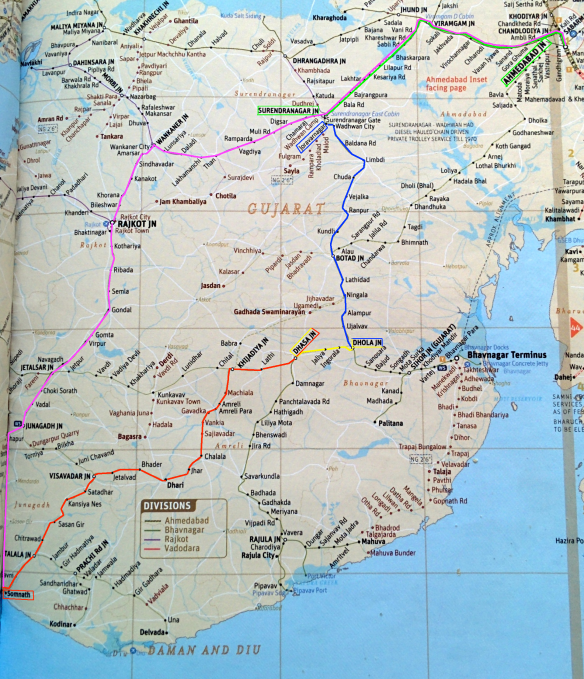

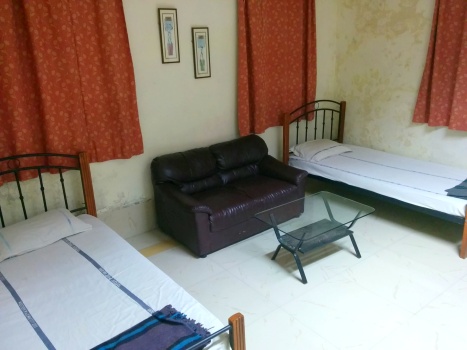


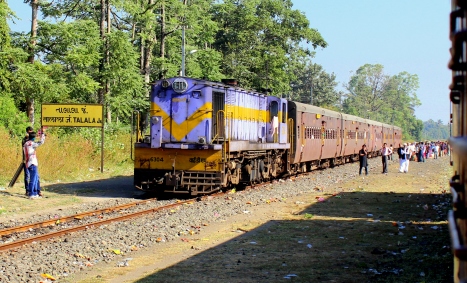
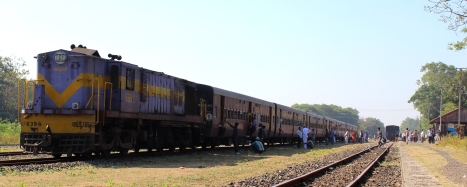

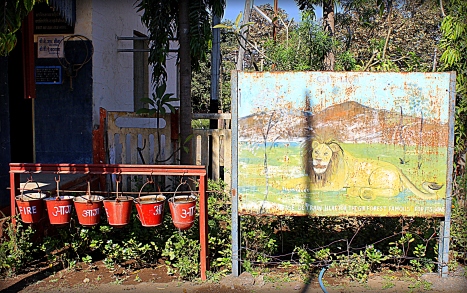
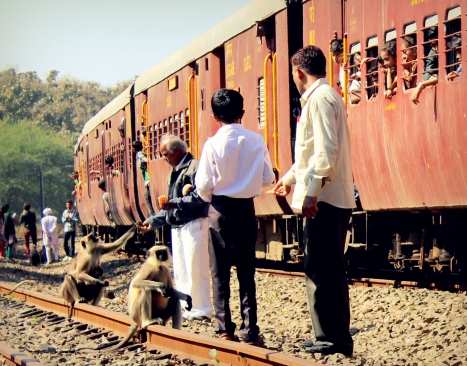
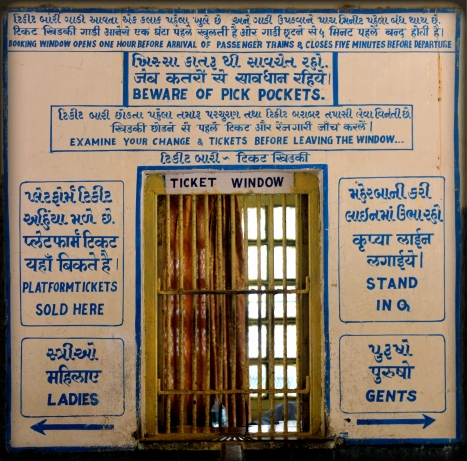
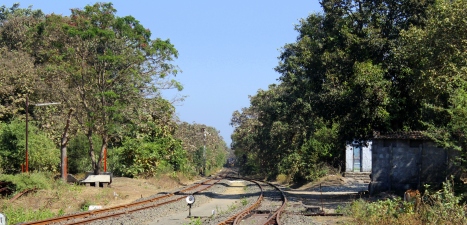
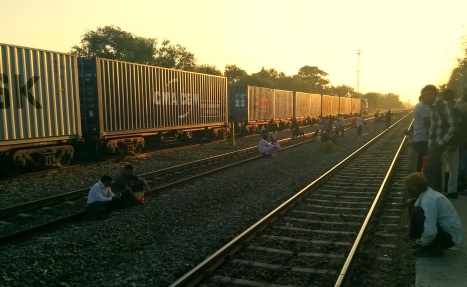

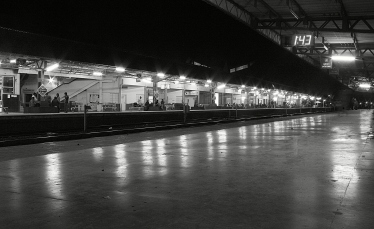
Fun to read your blog. I had a Great trip around Gujarat in Feb/ March 2012 … how funny I took a very similar shot in Sasan Gir. http://www.flickr.com/photos/malc_c/7837262218
All the best
Malc
LikeLike
An excellent write up has enticed me to plan such a trip, as you even i haven’t explored this part of Gujarat. This will definitely serve as a guiding blog for my future tour.
LikeLike
I would like to thanks to saw your interest in our saurashtra rural aria I would like to give an invitation to come at our city and our home
LikeLike